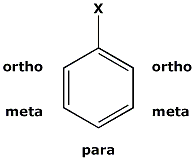
Ring Substituent Effects
Activating substituents: After the first reaction the second (and third if applicable) follow at increased speeds. I.e. substitution increases reactivity. Examples: -OH, -NH2, -Me,
Deactivating substituents: Reaction stops after the first substitution. I.e. substitution decreases reactivity. Examples: -CF3, -NO2, -CN, -F, -Cl, -Br, -I,
Ortho, para-directing: Substituents which directs electron density onto the ortho and para positions. Hence substitution occurs preferentially on those sites. Selectivity between the sites is often decided by steric effects. Generally electron releasing groups. Examples: -OH, -NH2, -Me, -F, -Cl, -Br, -I,
Meta-directing: Substituents which draw electron density from the ortho and para positions, hence increasing reaction on the meta position. Examples: -CF3, -NO2, -CN,
Donation or withdrawal of electrons can occur via either a conjugative or an inductive effect.
| Electronic Effect | Examples | Activation Effect | Direction |
| donation - conjugation | -NH2, -OH | very activating | ortho, para |
| donation - inductive effect | -Alkyl | activating | ortho, para with some meta |
| donation - conjugation, withdrawal - inductive effect | -F, -Cl, -Br, -I | deactivating | ortho and (mostly) para |
| withdrawal - inductive effect | -CF3 | deactivating | meta |
| withdrawal - conjugation | -NO2, -CN | very deactivating | meta |
